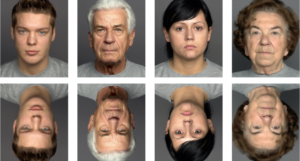Understanding genetic risk could save sight and predict multiple sclerosis earlier in young people

Optic neuritis was early sign of MS for Hermione
Young people could be spared from going blind by a new genetic risk tool that could also help diagnose multiple sclerosis (MS) earlier, to start effective treatments.
Optic neuritis is a condition that affects people of all ages, but especially young adults, usually manifesting in blurred vision and sometimes pain when moving the eyes. Up to half of people affected in the UK eventually go on to develop MS – often many years later. Emerging evidence indicates that starting the very effective MS treatments earlier may improve long term health.
Optic neuritis occurs because of swelling in or around the optic nerve. For those with MS-related optic neuritis, the swelling subsides on its own, and vision usually recovers. For many people whose optic neuritis does not result from MS, the optic nerve can be permanently damaged unless high doses of steroids are given quickly, resulting in loss of sight. However, steroids can result in harmful side effects. When people first develop optic neuritis, it can be difficult for patients and their doctors to decide whether the possible benefits of steroid outweigh the possible harms, when the likely cause of the optic neuritis is unclear.
Identifying whether there is an underlying cause of optic neuritis can be challenging for clinicians, with many important test results taking weeks to return. Now, new research, published in Nature Communications and led by the University of Exeter and King’s College London, has shown for the first time that combining genetic risk for MS with demographic factors significantly improves MS risk prediction in people presenting with optic neuritis.
Co-author Dr Tasanee Braithwaite, consultant ophthalmologist to the Medical Eye Unit at Guy’s and St Thomas NHS Foundation Trust, and Adjunct Senior Lecturer at King’s College London said: “As a doctor caring for many patients with optic neuritis, I’m excited by the possibility of translating this pilot research into front line clinical care in the near future. Whilst more research is needed, our study provides a strong signal that we could better identify patients at high risk of MS, perhaps enabling these people to have earlier MS treatment in the future. Whereas, if we could better identify people whose optic neuritis is very unlikely to result from MS, we could treat these people urgently to reduce irreversible vision loss and blindness.”
The team analysed more than 300 common genetic variants linked to developing MS, combining them into a genetic risk score that helps clinicians understand an individual’s chance of developing MS. They analysed data from 500,000 people in UK Biobank, who have shared genetic samples, questionnaires and linked health information from their electronic medical records.
The researchers found 2,369 people who had MS in the UK Biobank, and 687 people with optic neuritis. Of those, 545 had no identifiable cause for their optic neuritis at the start of the study, and 124 went on to develop MS.
Applying the genetic risk score effectively helped separate those at lowest risk from those at high risk. Whilst the MS genetic risk score is not a diagnostic test, this study highlights that it could add one valuable additional piece of information to support doctors and patients to make better decisions.
Co-author Professor Richard Oram, of the University of Exeter Medical School, said: “Since the first genome was sequenced three decades ago, we’ve been working towards the promise of being able to use genetics to improve outcomes for individual patients. This research is an excellent example of precision genetic diagnosis in practice.”
Dr Clare Walton, Head of Research at MS Society, said: “Currently, 130,000 people live with MS in the UK and one in five will have experienced optic neuritis at the start of their MS journey. This research shows how using genetic scores could be a useful way to predict who will likely continue to an MS diagnosis.
“Using immunotherapies in people at high risk of MS could significantly delay the onset of the condition, but these drugs come with side effects. This exciting study opens up the possibility of finding people in which the benefits will outweigh the risks.”
The research stemmed from a summer project led by University of Exeter Medicine student Pavel Loginovic. With funding from the University of Exeter, it expanded into a research collaboration involving academics the Finngen Study in Finland and the Geisinger Study in the US. The research was further funded through Fight for Sight and the Royal College of Ophthalmologists, who awarded Dr Braithwaite a Zakarian Award to support this work.
Pavel said: “I’m elated to see this paper published, and it’s gratifying that it could have a real impact in moving research forward, ultimately aiming to get people with MS diagnosed and perhaps treated earlier. Leading this analysis while staying on top of my medical studies has been a challenge and an immense opportunity for growth, professional and personal. I’ve enjoyed the academic journey so far, and I’m excited for what’s to come.”
The study is entitled, ‘Applying a genetic risk score model to enhance prediction of future Multiple Sclerosis diagnosis at first presentation with optic neuritis’, and is published in Nature Communications.
Hermione’s story:
Hermione Russell has had a rollercoaster two years. Now 29 and expecting her first baby, she is also coming to terms with a diagnosis of multiple sclerosis (MS).
The advertising director was just 27 when she first noticed something amiss with her vision, which turned out to be the first sign of MS. “At first I noticed a painful irritation and it hurt to move my eye, which I thought was linked to my contact lenses – but over just a few days, it started to get progressively worse. Soon my vision was incredibly blurry.”
Initially, tests could not find anything amiss, but opticians in London soon mentioned the possibility of optic neuritis, and the possibility that it could be an early sign of multiple sclerosis (MS).
“At that point, the idea that I could have MS freaked me out so much,” said Hermione. “I was really panicky.”
Hermione went to Guy’s and St Thomas’, where clinicians noticed the optic nerve was slightly inflamed and she had very poor peripheral vision. Over the next few days, a brain scan confirmed optic neuritis and she was put on steroids, as there was no sign in the brain of MS. Dr Tasanee Braithwaite continued to monitor Hermione over the coming two years. After she developed an occasional hand tingle, Dr Braithwaite called her in for another brain scan, which resulted in a diagnosis of suspected MS in August.
“My first brain scan was clear, so the optic neuritis was the first indicator, but lesions have since shown up that indicate MS, so the eye problems were the very early stages for me,” said Hermione. “It’s been a real rollercoaster. I’ve had about two years to come to terms with the fact that I might have MS. If I’d been diagnosed in 2021, I would’ve been completely devastated, but since then I’ve learned that nowadays, there are loads of treatments that can really make a huge difference to outcomes with MS. The treatment can be well tailored to the type of MS you have – as long as you’re diagnosed early.
“Obviously I’m not thrilled – I’d rather not have to worry about any of this. But I know that in a way I’m lucky. I was diagnosed early and the research has advanced at an incredible pace over the past 20 years, so now I’m confident I can live well with MS.”
Hermione welcomed the findings of this study which has shown that using a new genetic risk tool might significantly improve MS risk prediction in people presenting with optic neuritis for the first time. She said: “Getting the best information as early as possible really improves the chances of the best possible outcome. We need to make sure people have the emotional support in place as people come to terms with these revelations, but ultimately extra information about risk would help to empower people to have agency over their own health.”



